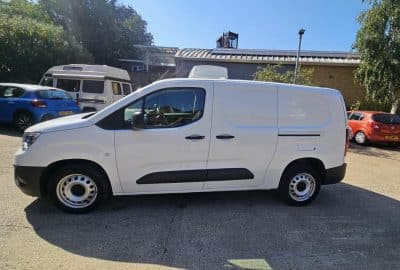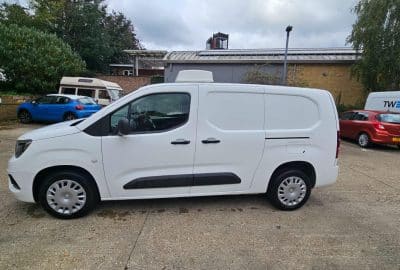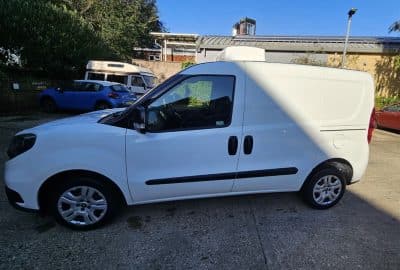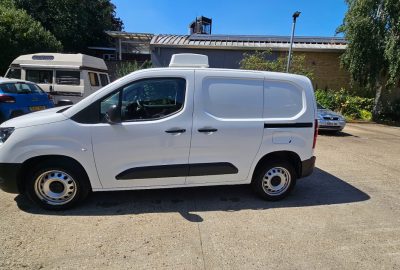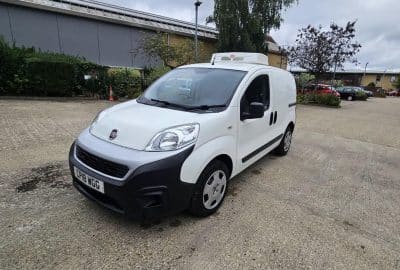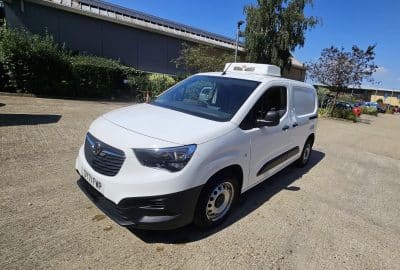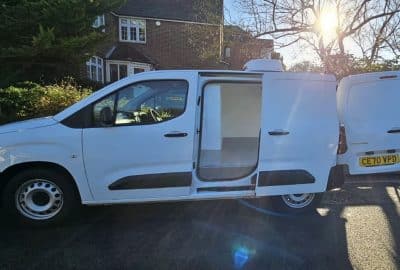A refrigerated van or truck is a vehicle used to move and store perishable cargo at specific temperatures. It is equipped with cooling equipment that helps keep the cargo at a steady temperature, until it arrives at its destination. We install powered refrigeration units into our Refrigerated vans – other companies prefer vans that are ice-cooled with dry ice, or carbon dioxide-cooled using liquid.
What Are Refrigerated Vans Used For?
The high demand for perishable goods creates a need for reliable preservation systems. Freshness and safety of cargo intended for human consumption must be guaranteed, and microbial activity must be halted. Chemical composition must also remain untainted, and this is especially important for food products such as dairy, meat, fruits, and vegetables.
Pharmaceutical products have a special need for temperature-controlled logistics. Medical supplies must remain sterile, while certain drugs must be kept below specific temperatures to retain their efficacy. Other drugs can have potentially fatal consequences if they spoil, so refrigerated trucks are indispensable for their transportation. Refrigerated vans are used to transport fresh, perishable products, or temperature-sensitive products and equipment in the appropriate atmosphere. These products include:
Food: Perishable food like meat, fruits, vegetables, milk and cold beverages, are transported in a refrigerated van to ensure they don’t decay or perish.
Flowers: This ensures that flowers don’t wilt while in transport to various locations.
Insects: Some insects need to be transported in a cold temperature. For example, honey bees are transported to farms to pollinate corn and other food. Transporting them in a cool atmosphere prevents heat from damaging the colony.
Animals: Birds like penguins are transported with temperature-controlled trucks when they change their nests.
Cosmetics: Some cosmetics, like lipstick and other makeup products, need a cool temperature after being manufactured. They’re transported in fridge vans to keep them at an appropriate temperature before they get to the counter.
Perfumes: The chemical composition of perfumes is very delicate. Transporting them in a refrigerated van ensures that their chemical composition and fragrance doesn’t change.
Medical supplies: Medical supplies and medication are temperature sensitive. Items like flu vaccines, or blood required for a transfusion, need to be kept at the right temperature at all times.
Equipment: Appliances such as sound systems are temperature sensitive and need a cool environment when they’re moved from one location to another.
Temperature controlled vans are used widely in supply chains of diverse sectors. With the right refrigerated van, you will deliver your products to your customers in optimate condition.
2019 Vauxhall Combo L2 H1 Fridge Van For Sale
2020 Vauxhall Combo 2300 100 L2 H1 Fridge Van For Sale
2021 Fiat Doblo L1 H1 Cargo Fridge Van For Sale
2022 Vauxhall Combo Dynamic L1 H1 Fridge Van For Sale
2021 Vauxhall Combo 2300 100 L2 H1 Fridge Van For Sale
2018 Fiat Florino Professional Fridge Van For Sale
2021 Vauxhall Combo L1 2300 Dynamic Fridge Van For Sale
2020 Citroen Berlingo L1 H1 Fridge Van For Sale
2020 Vauxhall Combo Sportive L1 H1 Fridge Van For Sale
20 reg. Citroen Berlingo 1.5 Blue HDi L1 H1 Enterprise Fridge Van For Sale
Temperature-Controlled Vehicles for Transportation & Logistics
Temperature-controlled logistics is primarily concerned with the storage, preservation and transportation of temperature sensitive cargo. Such cargo is often subject to atmospheric degradation and, as a result, demands a steady temperature to slow it down. An unbroken cold chain is an uninterrupted series of refrigerated production, storage and distribution activities. Along with related equipment and logistics, the optimal low-temperature range must be maintained. Cold chain management and logistics is a specialised task within supply chain management. It employs temperature-controlled transportation, storage and distribution systems to ensure that the product stays within its recommended temperature range.
Sub-zero or elevated temperatures can impact the quality of food, and the composition and chemical stability of medicines. Sedimentation and separation of emulsified products also need to be considered when looking at the physical properties of the cargo. In relation to the implications of improperly stored drugs, standard procedures are highly regulated, and pharmaceutical companies must prove a temperature-controlled supply chain is used to distribute their products.
The margin of error varies from product to product; there is greater regulatory emphasis on drugs that retain integrity between 2 degrees Celsius and 8 degrees Celsius. Drugs that are kept above sub-zero temperatures are typically stored in this temperature range, and manufacturers, shippers, and wholesalers must each guarantee these conditions are adhered to. Shipping services account for maintaining cargo temperature, while manufacturers must ensure that all parties involved understand the need to maintain the optimal conditions for the product.
Choosing a temperature-controlled refrigeration van requires careful consideration before choosing one as a refrigeration solution. You must assess factors such as the acceptable risk levels, potential risk areas and touch points, acceptable temperature and humidity range, specific no-go actions that could impact product integrity, and the temperature margin of error
Other factors to be considered in the selection of a cold storage system like a refrigerated van would include temperature controls, back-up temperature controls, whether temperatures have been tested, cargo placement, avoiding areas where temperature variations are more likely, volume of products, the temperature range and volume of cargo, layout of the storage unit and airflow, and external temperature logging and data tracking.
The biggest consideration when choosing transport for cold chain supply chain logistics, is the possible risk to the end-user should the cargo experience a delay in delivery. Thorough risk assessments are important when selecting the appropriate refrigeration van, including the costs of replacing your shipped product should issues arise.
How Temperature-Controlled Van Refrigeration Units Work
A small used van must have certain features if it is to be used commercially. Our specialist team at Glacier Vehicles ensures that all our used cooling vehicles are properly engineered, delivering optimal and efficient cooling of our customers’ products. With over 20 years of experience under our belts, we are very familiar with all your requirements. We guarantee that our small used fridge vans are optimised for quality temperature control.
Thermal Insulation in Fridge Vans
Insulated airtight compartments are a standard feature of refrigeration vehicles. To be successful at maintaining low temperatures, a vehicle needs insulation of higher quality and thickness than that used in household refrigeration units. An insulated lining works by slowing down the rate of heat penetration of a vehicle. The thicker it is, the more it can preserve the temperature in the van. But there has to be a balance between efficiency and what is practical. Thick insulated lining affects the payload capacity of the vehicle, as it contributes to the van weight and reduces the cargo carrying capacity.
Thermal insulation comes in the form of a very dense polymer foam, similar to the one used in Styrofoam cups, except much denser. This foam is sprayed on all surfaces within the designated cargo area of the van. It is important to cover the entire surface area in order to leave no vulnerable spots through which heat can penetrate. This foam performs its function excellently because it is a very bad conductor of heat, and so, the thicker the layer of foam sprayed, the better the performance of the insulation.
Once the polymer foam is sprayed on, we overlay it with a protective coating. This protective coating exists mostly to prevent damage to the foam during loading and unloading of the vehicle. It is hard and spill resistant. The coating also protects the inside of the van from stains. The two major coating types we use are:
Wet Lay – A more popular form of coating. It is highly effective and is a sprayed-on liquid polymer which covers the foam. The polymer hardens once it makes contact with air, resulting in a solid, durable surface. It is easier to cover every part of the foam using this technique.
Dry Lay – The major distinction between wet lay and dry lay is that dry lay already exists in a solid form during the installation process. It arrives as tiles of hard plastic. It is similar to the polymer sprayed onto the foam when wet laying. Although more cost effective, it increases the possibility of bacteria breeding in the pores between the tiles. This can be problematic, especially in the transportation of food items.
Thermal Engineering in Fridge Vans
A refrigerated van system is a sealed cabin. The target compartment is sealed with a high-density polymer to give a heat-resistant environment. The other crucial part of the process is the removal of heat via a condenser, a compressor, and an evaporator. Some heat can still travel directly through insulation, or around it, and both of these problems must be addressed to make the insulation effective. Adequate thickness and good quality of the insulation manages the heat going through it, while a high standard of design and fitting tackles leaks and weak points.
Extruded polyester (from polystyrene polymer) is the preferred material for thermal insulation purposes. It is rigid and fabricated using an extrusion process giving high compressive strength, minimal water absorption, and excellent thermal performance. It is also lightweight and allows for an excellent quality of insulation in refrigerated van conversions, while making optimal payload capabilities possible.
A 50-millimetre thickness for a refrigerated van and a 75-millimetre thickness for freezer vans are extremely effective specification. The insulation for the sides and roof of the van are also permanently bonded together using glass-reinforced fibreglass (GRP), and plastic manufactured using a woven roving process will improve the strength and thickness of the lamination. We cut the insulated lining with modern machinery, allowing for a custom fit appropriate for each refrigerated van, matching the van make and model requirements and resolving the issue of effective installation.
The bulkhead section of the refrigerated van is only bonded with GRP plastic on one side, while the other side is fitted with a veneer of plywood and then completely covered with carpet to perfectly match the van interior. The fridge van floor insulation is also bonded using plywood as woodboarding, and then laminated to create a hygienic floor. This is a standard feature of all Glacier Vehicles’ refrigerated van conversions or small used Refrigerated vans. These steps make for efficient insulated lining of optimal thickness. We use thermal imaging cameras to identify any leaks within the refrigerated van conversion, which allows us to rectify any heat penetration before delivering our top class Refrigerated vans to our customers.
The powered refrigeration system works by removing traces of heat from the system and dissipating this outside. When done in an insulated environment, the temperature can be lowered significantly. A sufficiently thick insulation along with a powerful condenser system can reduce temperatures to freezing or even lower. The entire apparatus has three primary elements – a condenser, a compressor, and an evaporator. The condenser is a mesh of thin pipes containing a special coolant fluid. This liquid has the sole purpose of absorbing heat in an extremely efficient way. As the liquid flows through the piping, it absorbs heat inside the system, warming up the coolant and turning it into a gas as it circulates.
Once it reaches the other end of the pipe network, it enters a compressor where it is subjected to extremely high pressure. The evaporator then pushes air from the outside through the high-pressure gas. This cools the coolant gas back into a liquid, while any heat is dissipated into the atmosphere outside the van, thereby, reducing the temperature within the insulated compartment. Electricity is required for the process described. The absence of a mains socket in a mobile refrigerated van has necessitated the use of a direct drive mechanism that draws power from the fridge van’s engine. Some Refrigerated vans can use a separate generator, which is important if the van remains parked for extended periods, as is the case with on-site catering. Direct drive, however, is simpler and more efficient.
Temperature Control in Refrigerated vans
Modern temperature control systems sometimes employ eutectic cooling. This involves frozen columns within the refrigerated vehicle. The columns are filled with a special absorbent gel, which is frozen overnight, using the mains supply. As the columns unfreeze over the next day, they eliminate heat within the refrigerated compartment of the vehicle. Eutectic columns can be very expensive and are only feasible for certain refrigerated van types.
However, most common cooling systems employ the same mechanical cooling apparatus found in a standard refrigerator. This functions by sending coolant fluid throughout a condenser, and is usually located in the roof of the van’s chilled compartment. The coolant traps the compartment heat, then the heat is expelled from the vehicle top into the atmosphere.
What Components are Used in Your Refrigerator Van/Conversion?
Glacier Vehicles’ refrigerator van conversions rely on kits supplied exclusively by GAH refrigeration systems. Their refrigeration units feature a stylish aerodynamic design, with plastic covers for the condenser and evaporator. There is a sealed single-phase rotary compressor for standby purposes. There is also the insulated cool box/cargo compartment to consider. These can be chilled or frozen or even simultaneously heat and cool separated compartments within the same van. Dual compartment Refrigerated vans are able to maintain a temperature range of 0 degrees Celsius to 5 degrees Celsius.
Refrigerated Vans Cargo Options
Common refrigerated van cargo options include meat rails, slide drawers, wet load or slip resistant floors, standby capability, extra shelving or racking, and strip curtains. The selection of options will depend on your requirements and intended use of the refrigerated van.
Types of refrigerated van
Refrigerated vans can be classified on the basis of their wheelbase. This is the distance between the centrelines of the front and rear axles. A vehicle designed for high speed cornering will be lower to the ground, it will however, feature a much longer wheelbase. The wheels are set closer to the front and back of the vehicle. A lengthened wheelbase means the interior space can be increased. Wheelbase influences a vehicle’s turning radius.
Long Wheelbase (LWB)
A long wheelbase is a wheelbase longer than a vehicle’s standard wheelbase option. A longer wheelbase also rides better due to the higher time interval in which front and rear wheels hit bumps. Finally, a long wheelbase feels more stable at speed due to its larger footprint on the road.
Medium Wheelbase (MWB)
A medium wheelbase aims for a hybrid of speed and balance to compensate for vehicle payload capabilities.
Short Wheelbase (SWB)
A short wheelbase vehicle can usually corner faster, being perhaps less aerodynamic. Along with the track, the wheelbase affects a vehicle’s steering angle – how sharply it can turn.
What Are Your Recommended Vehicle Brands?
We work with the best van manufacturers in the industry. As a result, we are able recommend the best refrigerated vehicles for you. Our small to medium temperature-controlled vans are 2 pallets, with an inner length of 2 – 2.5m. They have a payload of between 400 kg to 800 kg, depending on the model and brand. Below are some of our most popular brands:
- Ford Transit
- Large Vans
- Fiat Scudo
- Peugeot Expert
- Citroen Dispatch
- Volkswagen Transporter
- Mercedes Vito
- Vauxhall Vivaro
- Renault Trafic
- Ford Custom
Van Features
All small used Refrigerated vans from Glacier Vehicles come with certain standard features. These include a full service history, full MOT benefits, multi-point checks and generous guarantees and warranties (including the remainder of the manufacturer warranty). Our own Glacier Vehicles 12-month warranty, and the refrigerator system’s 12-month warranty is also included. We offer free delivery to your preferred location in the UK and we make callouts available throughout the UK, as an extendable option. Our conversions are new and our vehicles cater to all types of businesses. Whether you are a catering service in need of a vehicle to move around town quickly, or you need to invest in a long-haul refrigerated vehicle, you can trust us to help you get exactly what you need. Get in touch with us today for advice and recommendations on the vans we have in stock, or ask us to source the type of vehicle that you have in mind.
Optional Extras
When looking at small Refrigerated vans for your operations, handy features which you can request on all of our stock include alarm systems, LED daytime running lights, air-conditioning, Bluetooth, cruise control, rear parking sensors and satellite navigation. Many of our customers prefer to add extra features to their vans. We provide optional extra features that can make you more comfortable, add security to your vehicle, or aid in your transport and business activities.
We provide air conditioners, with the latest original technology, for the comfort of the drivers and passengers. We also provide cruise control, for comfort and ease when driving.We provide alarm systems for security, and parking sensors, so that you don’t run into an object when reversing or parking. We also provide LED daytime running lights, to make your car visible in low visibility areas for added safety.
We provide Bluetooth functionality, so that you can connect your phone to your van and have hands free access to the functions of your phone. You can still answer customer calls without handling the phone and complete your business communications while driving safely. We also provide satellite navigation. Not only will you get directions to unfamiliar delivery points, you’ll also be able to know the fastest route to your clients’ delivery locations. We provide these extra customisation features on request from our clients. If you have a van already and you want us to convert it to a refrigerated vehicle for you, we can also do that.

